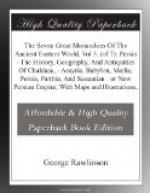It was during this time of comparative purity, when the anti-idolatrous spirit was in full force, that a religious sympathy seems to have drawn together the two nations of the Persians and the Jews. Cyrus evidently identified Jehovah with Ormazd, and, accepting as a divine command the prophecy of Isaiah, undertook to rebuild their temple for a people who, like his own, allowed no image of God to defile the sanctuary. Darius, similarly, encouraged the completion of the work, after it had been interrupted by the troubles which followed the death of Cambyses. The foundation was thus laid for that friendly intimacy between the two peoples, of which we have abundant evidence in the books of Ezra, Nehemiah, and Esther, a friendly intimacy which caused the Jews to continue faithful to Persia to the last, and to brave the conqueror of Issus rather than desert masters who had shown them kindness and sympathy.
The first trace that we have of a corrupting influence being brought to bear on the Persian religion is connected with the history of the pseudo-Smerdis. According to Herodotus, Cambyses, when he set out on his Egyptian expedition, left a Magus, Patizeithes, at the capital, as comptroller of the royal household. The conferring of an office of such importance on the priest of an alien religion is the earliest indication which we have of a diminution of zeal for their ancestral creed on the part of the Achaemenian kings, and the earliest historical proof of the existence of Magism beyond the limits of Media. Magism was really, it is probable, an older creed than Zoroastrianism in the country where the Persians were settled; but it now, for the first time since the Persian conquest, began to show itself, to thrust itself into high places, and to attract general notice. From being the religion of the old Scythic tribes whom the Persians had conquered and whom they held in subjection, it had passed into being the religion of great numbers of the Persians themselves. The same causes which had corrupted Zoroastrianism in Media soon after the establishment of the Empire, worked also, though more slowly, in Persia, and a large section of the nation was probably weaned from its own belief, and won over to Magism, before Cambyses went into Egypt. His prolonged absence in that country brought matters to a crisis. The Magi took advantage of it to attempt a substitution of Magism for Zoroastrianism as the religion of the state. When this attempt failed, there was no doubt a reaction for a time, and Zoroastrianism thought itself triumphant. But a foe is generally most dangerous when he is despised. Magism, repulsed in its attempt to oust the rival religion, derived wisdom from the lesson, and thenceforth set itself to sap the fortress which it could not storm. Little by little it crept into favor, mingling itself with the old Arian creed, not displacing it, but only adding to it. In the later Persian system the Dualism of Zoroaster and the Magian elemental worship




